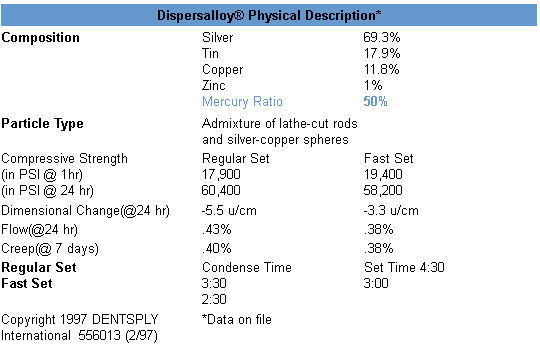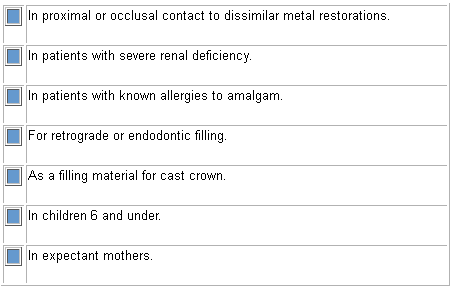Composizione
DALLA SCHEDA DI SICUREZZA DI UN PRODUTTORE, PRIMA CHE FOSSE RITIRATA E RISCRITTA
From Dentsply Caulk, the makers of Dispersalloy®
"The world's most widely used alloy"

"With over 25 years of proven clinical performance in millions of restorations, Dispersalloy® is the world's most widely used alloy. Its consistent mix of lathe-cut particles and silver-copper eutectic spheres virtually eliminates the Gamma-2 phase, yielding exceptional corrosion resistance and reduced ditching. And thanks to its patented self-activating capsules, no activation tool is needed. Dispersalloy® is also available in powder and tablets."

Below is a copy of the original 'Dispersalloy DFU' from the Dentsply Caulk website, which was withdrawn in early 1998 after attention was brought to the Caulk company's listing of the contraindications to the use of amalgams. All the text is unchanged. The graphics at the top of the original document, however, were removed because the original *.gif files were not saved, and some of the links back to Caulk at the bottom of the page have been inactivated.
DIRECTIONS FOR USE
Dispersalloy®
Tablets and Powder
A dispensed phase admix amalgam, containing lathe-cut particles and silver/copper eutectic spheres. Caution: U.S. Federal law restricts this device to sale by or on the order of a dentist. For dental use only.

Indication for use
Dispersalloy® should be used in stress bearing restorations (Class 1 and 2), when other restorative materials or restoration techniques are not indicated.
Contraindication
The use of amalgam is contraindicated:

Side Effects/Warning
Prior to use, read the MSDS information and product instructions for this item.
Exposure to mercury may cause irritation to skin, eyes, respiratory tract and mucous membrane. In individual cases, hypersensitivity reactions, allergies, or electrochemically caused local reactions have been observed. Due to electrochemical processes, the lichen planus of the mucosa may develop.
Mercury may also be a skin sensitizer, pulmonary sensitizer, nephrotoxin and neurotoxin.
After placement or removal of amalgam restorations, there is a temporary increase of the mercury concentration in the blood and urine.
Mercury expressed during condensation and unset amalgam may cause amalgamation or galvanic effect if in contact with other metal restorations. If symptoms persist, the amalgam should be replaced by a different material.
Removal of clinically acceptable amalgam restorations should be avoided to minimize mercury exposure, especially in expectant mothers.
Precautions
The number of amalgam restorations for one patient should be kept to a minimum.
Inhalation of mercury vapor by dental staff may be avoided by proper handling of the amalgam,the use of masks, along with adequate ventilation.
Avoid contact with skin and wear safety glasses and gloves.
Store amalgam scrap in well sealed containers. Regulations for disposal must be observed.
DISPERSALLOY® CONTAINS ZINC; THE AMALGAM MADE THEREFROM MAY SHOW EXCESSIVE EXPANSION IF MOISTURE IS INTRODUCED DURING MIXING, CONDENSING AND COMPACTING.
Proportions
As with all alloys, the ratio mercury to alloy is important. A 1:1 mercury/alloy ratio is recommended. When using either Dispersalloy ® Tablets or Powder, we recommend using an automatic powder and mercury proportioner. It will automatically and precisely dispense measured amounts of mercury and alloy. Refer to the instructions provided by the proportioner manufacturer.
